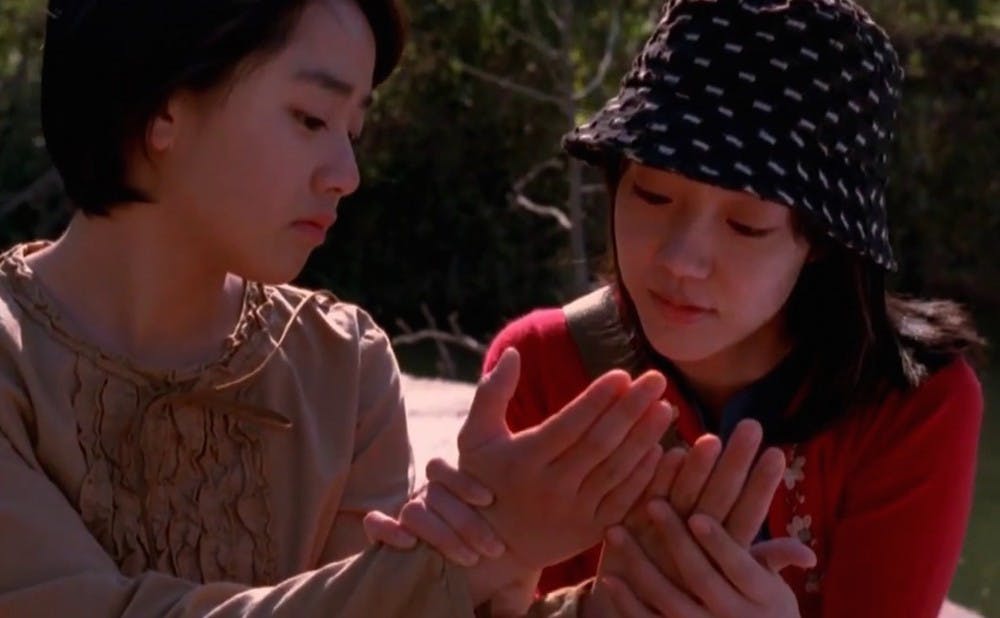Jee-Woon Kim’s 2003 horror film “A Tale of Two Sisters” juxtaposes beautiful images of a rustic landscape and gory illusions of tortured ghosts. Duke’s Asian/Pacific Studies Institute (APSI), in collaboration with Screen Society, held a screening of the South Korean film, and a Q&A session with the director Oct. 28 at the Rubenstein Arts Center. Although the film was fraught with cliches that persist in both the horror and fairytale genres — a haunted house and an evil stepmother — it moved the audience with a potent message regarding the lasting impact of traumatic memories.
“The film’s dysfunctional domestic space … is a condition common [not only] in Korea, but also around the globe today,” Nayoung Aimee Kwon, associate professor in the department of Asian and Middle Eastern studies, said in her introduction of the movie. “The film plays [on] the common trope of the monstrous mother and females pitted against one another within a patriarchal hierarchy in decline and the impotent father figure, who has to stand on the sideline, completely helpless.”
The event was a part of the APSI’s Cine-East: East Asian Cinema series, which screens several South Korean films annually on campus. Kwon was in charge of coordinating the visit of Kim, who showed two of his movies.
“‘A Tale of Two Sisters’ and ‘The Good, the Bad, the Weird’ were chosen because they both received raving critical and popular reception both domestically and internationally, and showcase the eclectic range of Kim Jee-Woon’s filmography,” Kwon wrote in an email. “His films take conventional genres … and completely [transform] them into something else.”
Since Kim began writing films in his mid 30s it had always been his dream to make a “sad but beautiful” movie. He said he achieved the goal through “A Tale of Two Sisters,” which received critical acclaim for its use of mise en scene. Kim strategically placed objects in each scene and related them to the haunting memories the main character, Sumi, held about the death of her younger sister, Su-yeon, and her mother in their family home.
“For me, the space represents what is missing in the characters’ lines,” Kim said through an interpreter. “I wanted to show how spaces can bring forth bad memories.”
Returning from a mental hospital, Sumi arrives at an isolated old house in the mountains where she meets her evil stepmother, Eunjoo. Throughout the movie, viewers hear uncanny noises and tormented ghosts appear in several jump-scare scenes. Such familiar horror movie and fairytale motifs and premises draw viewers into the film.
“Plots from folktales can help the viewers access the movie much more easily,” Kim said. “But at the same time, I would input my own cinematic aesthetic to create a fresher approach.”
Eunjoo’s abuse of her step-daughters seem to explain Sumi’s hatred toward her. According to the director, the stepmother also reminds the viewer of mistrust and fear toward outsiders prevalent in a lot of communities. Eunjoo used to be a caregiver of the sisters’ sick mother, but marries their father after the mother passes away. Such plot devices also lure the viewers to easily relate to Sumi’s agonies.
Viewers also come to realize that Sumi is still mentally ill: She continues to take unknown medications and have unsettling hallucinations in her nightmare. Her illness is aggravated with a sense of guilt when she begins to believe that Eunjoo killed Su-yeon by locking her in a closet, leaving her unable to rescue her younger sister. The conflict between the terrified daughter and the stepmother builds up psychological tension of the movie, leading to the plot twist.
“I borrowed the structure of stepmom [stories],” Kim said. “But it is not just to create an ending as good people getting rewarded and bad people getting punished, but to create animosity toward the stepmom [of] the main character, and also to show the idea that mental illusion, hallucination, and...bad memories can haunt you.”
Meanwhile, the father cannot help his daughter recover. He tries to convince himself that finding a new mother for his daughters was a necessary choice. But knowing that his relationship with Eunjoo was the main cause of the conflict between her and the daughters and the tragedy of his family, he faces internal troubles.
“Because his wife was ill, he probably thought that there should be another mother figure for the daughters, [but] maybe he had other desires and impure thoughts,” Kim said. “I feel like he had a wrong handling [of] … the importance of the family.”
According to Kwon, there have been debates about whether “A Tale of Two Sisters” and other movies with evil stepmothers and helpless fathers are inherently conservative; despite portraying oppressed women and their ghosts seeking to defy the patriarchal society, the stories eventually return to the status quo after either the revenge is over or the ghosts are punished. However, some argue that the genre can have some feminist twists.
“These focus on the agency of the vengeful ghost, especially that of the wronged woman, who returns as a powerful and subversive figure of resistance seeking justice in the patriarchal order,” Kwon said. “‘A tale of two sisters’ asks questions about the wronged women, haunting, lingering sense of guilt, retribution and the relationship between the past and the present.”
Get The Chronicle straight to your inbox
Sign up for our weekly newsletter. Cancel at any time.

